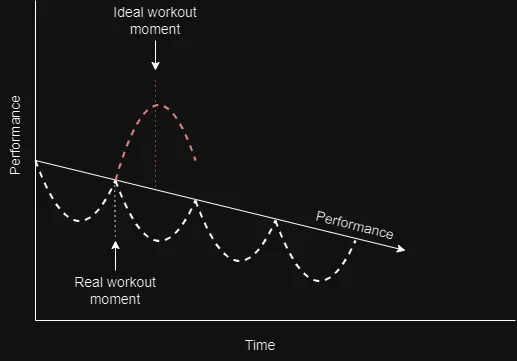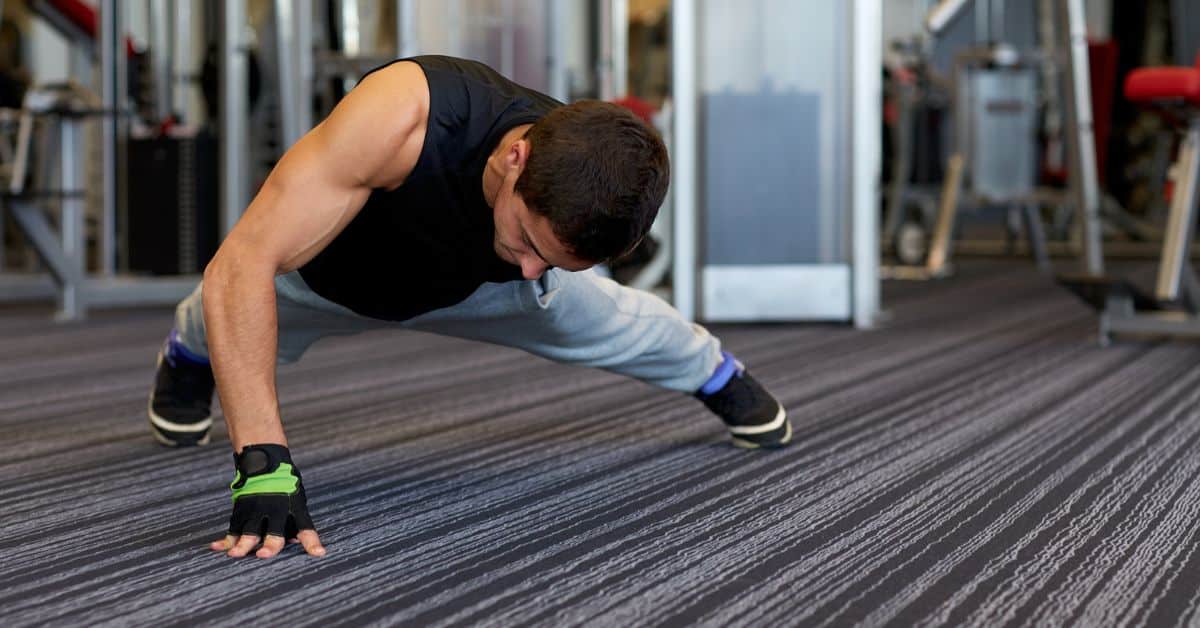- When Are You Overtraining in Calisthenics?
- Overtraining Means Resuming Training Before Supercompensation Finishes
- Waiting Too Long After a Workout
- Symptoms of Overtraining Calisthenics
- 6 Ways Fix Overtraining in Calisthenics
- Programming Your New Workout and Prevent Overtraining in Calisthenics
- Conclusions About Overtraining in Calisthenics
- Frequently Asked Questions About Overtraining Calisthenics
Overtraining in Calisthenics is a common occurrence, most often caused by a lack of a well-regulated Calisthenics Program despite the best intentions. I get it, you’re pumped with excitement to get fit and start building some muscle. The enthusiasm is there, but if you’re overtraining your Calisthenics, then you’re most likely lacking in discipline. I can hear you thinking. “But discipline means that you consistently push yourself and keep doing what you’re doing, right?” That is part of discipline, but if your consistency means that you’re hurting yourself, you’re doing something wrong. True discipline also means knowing when to hold back and prevent overtraining in Calisthenics.
When Are You Overtraining in Calisthenics?
In a nutshell, you are overtraining in Calisthenics if you resume workouts before Supercompensation can adjust to homeostasis. In even simpler terms, you work out again too soon. This point of homeostasis comes later than most people expect, as the Supercompensation that precedes homeostasis only comes after an initial period of recovery. I’ll explain overtraining in Calisthenics with the natural model for recovery and supercompensation, more in-depth.
Recovery and Supercompensation
To put it succinctly, after a workout you feel tired, maybe even sore, but you’re not fully recovered the moment that fatigue and soreness is gone. At best, you’re back at your previous level. Supercompensation is the process that builds more muscle and stamina than there was previously. This can only happen after your body has compensated first for the work out itself.
After a workout, your body goes through two cycles:
- Recovery, or compensation, for the workout itself by detoxifying and metabolizing nutrients.
- Supercompensation: to accommodate for what the body believes is the new normal workload, additional muscle mass and stamina are created.

At some point, your body will have reached a new homeostasis (a stable normal). You are stronger, faster, more endurant, and whatever other benefit your specific training gave you. By timing your next workout at the peak of supercompensation, you make the most efficient gains.

For the most optimal gains, in theory at least, your next workout coincides with the peak of your supercompensation period and right before your body tones down its previous homeostasis again. Since you cannot feel supercompensation happening, but you do feel the soreness of recovery, it is very easy to misjudge the next appropriate training time. You might feel fine after 24 hours and ready for your next workout. But what you’re really doing is interrupting the process of making new muscle mass.
Overtraining Means Resuming Training Before Supercompensation Finishes
After your recovery is done, you have not yet achieved a new homeostasis. You are not yet stronger, faster or more endurant. For this, supercompensation must first occur. Everybody (or rather, every body) reacts slightly differently to training. However, as a good rule of thumb, you can expect supercompensation to last the same amount of time as recovery took.
This means that if you felt sore for 24 hours after a workout, supercompensation will last for another 24 hours. It is during this time that you will see (but not feel) gains. If you do not allow for this additional time to reach a new homeostasis, you are overtraining. This may mean less optimal results since you are stopping supercompensation or, worse, might even mean you are progressively weakening your body.

Waiting Too Long After a Workout
You did a workout, recovered and underwent supercompensation. If you do absolutely nothing from then on, your body will undergo the reverse process. Your physical capabilities will deteriorate to your previous state.
This is because the body is always looking for homeostasis, a state where energy uptake and expenditure are optimized for long term survival. If you do nothing, the body believes times are easy and will dial down your muscle mass (because muscles require more nutrients to sustain).
This is why intermittent training with large gaps between workouts is rarely effective. At best, you can expect that type of training to maintain your current homeostatic normal.
Symptoms of Overtraining Calisthenics
You can tell that you are overtraining in Calisthenics when you are suffering in bodily physique despite doing technically correct exercises and workout routines. Look out for the following symptoms in conjunction with frequent exercise:
- Strength reduction, resulting in fewer repetitions or resistance levels despite doing them technically correct and frequently.
- Quicker to fatigue in general during your workout, resulting in not being able to complete a workout or not with the same level of vigor.
- Quicker to fatigue or constant feeling of fatigue when doing even simple tasks outside of training.
- Increase in brain fog or trouble concentrating on mental tasks.
- Trouble sleeping or feeling tired even after a normal or extended period of sleep.
These are indicators that your body is in a constant state of recovery. All your nutrients and energy are put towards recovering from the damage done from the previous workout and none of it is reserved for creating new muscle mass.
Overtraining is related to but distinctly different from injury. Injuries have more acute symptoms like pain, loss of function and acute loss of strength. Injury symptoms tend to be acute, whereas overtraining symptoms tend to be lingering. Overtraining your Calisthenics does make you more susceptible to injury, however. If you’re overtraining in Calisthenics but you haven’t yet sustained an injury, you are still relatively timely with your intervention.
6 Ways Fix Overtraining in Calisthenics
You’ve determined that you are overtraining your Calisthenics, and you want to fix it. What you need to do depends on several factors, the most important ones being how long you’ve been overtraining for and whether you sustained an injury. Use the following 6 methods to fix overtraining in Calisthenics but before you do, if you are uncertain about how you’re feeling you should always consult your General Practitioner first. This is even more important if you suspect an injury.
#1: Injury Recovery (Optional, unless it’s not)
If you’ve sustained an injury while being overtrained, I have some bad news for you. Your recovery will take the longest and will most likely see you lose a lot of the progress you did manage to make. This is because next to your Deload (#2), you will have to let your injury heal. This can sometimes be done in parallel, but it will most likely mean that you can’t exercise that part of your body at all for some time.
If you have an injury, you should always consult your doctor first on how to proceed. Your recovery might mean a combination of immobilization of the injury site, supporting garments and light mobilizing exercises or a Mobility Program. Rest and mobilization are your primary concerns here, which will put large muscle growth on the backburner.
I advise you to combine your injury recovery with steps #2 Deload, #3 All-Out Rest, and #4 Sleep, Eat and Relax to get the most efficient results possible under the circumstances.
#2: Deloading and Rest
If you’re not yet injured, your Calisthenics overtraining fix will start here. You need to take more rest and longer periods of rest between your workouts. I’ve explained above that supercompensation takes around as long as it took to recover and tacked on to that time. If you feel fatigued and sore for 24 hours, supercompensation happens for an additional 24 hours after that. You need to time your next workout to accommodate that supercompensation time.
You can benefit from a “Deload” period. This is a period in which you don’t completely stop working out, but you will reduce the load during your workouts. This means fewer sets and repetitions, lower resistance levels or easier variations. A good rule of thumb is to start with a 20% reduction of everything: repetitions, time under stress and resistance level. You do this in combination with a better Programming (#4b).
The time it will take before you feel like you can progress again will be related to the time you’ve spent overtraining your Calisthenics. If you’ve been overtraining your Calisthenics for half a year, it will take more time to Deload than when you were overtraining for 4 weeks.
#3 All-Out Rest Week
If you feel very fatigued, to a point where you are completely ineffective at the workout, you can precede your Deload (#2) with an all-out rest week. This is a week where you do no resistance training at all. You can do stretching but without any resistance, not bodyweight resistance either. This will help your body recover to its normal levels first and combat bodily fatigue. A single week of no training will not likely result in a loss of muscle mass.
If you are so fatigued from overtraining that you’ve become ineffective, you are losing muscle mass anyway from the very training you hope to gain muscle mass with. At that point, doing nothing will preserve more muscle mass than trying to work out again. The biggest risk then is that you lose the discipline to pick things up again.
Often, an all-out rest week can significantly reduce the Deload (#2) period required.
#4 Sleep, Eat, Relax
Almost all your recovery happens during your sleep. All recovery needs nutrients from food. No recovery can happen in a stressed state. In other words, you need enough sleep, the right food and enough time to relax.
#4a Fix Your Sleep Pattern
During your sleep your body kicks in high gear to recover and build new tissue. You need quality sleep and of sufficient quantity to recover, but most importantly is that it needs to be consistent if you want to see your training results come to fruition. Here are some pointers for getting quality, consistent sleep:
- Try and go to bed at around the same time every night, whether that is 9PM or 1AM. Consistency is the most important. Ideally, the biggest difference from your normal bedtime is no more than 2 hours (say on a weekend).
- Try and get most of your sleep in the dark of night, this helps get a more efficient and longer deep sleep.
- Ideally, you don’t need an alarm to wake up. You go to bed at such a time that you wake up naturally and with enough time to get ready for that day’s responsibilities.
- Don’t worry too much about the length of sleep. This is highly variable between people. If you go to bed at the same time every night and wake up naturally every morning, you’re getting enough sleep for you.
#4b Fix Your Diet
You might be working out all right, but you’re not seeing any results? The culprit might be your diet. A good Calisthenics Diet includes all the building materials your body needs for recovery and supercompensation. Without these, you’ll get weaker and weaker as you’re asking your body to do things it can’t. Luckily, getting a healthy diet isn’t hard but it does require a slight change of mindset. Supplements in Calisthenics are simple and optional, although recommended if you want to recover from your Calisthenics overtraining quicker.
This is how you maintain a good, balanced diet:
- Choose fresh over pre-processed food. Choose different foods every day.
- A traditional “third protein, third fibers, third starches” (meat, vegetables, potatoes/rice) warm meal is a huge upgrade over fast food or convenience meals.
- Substitute unhealthy snacks for healthy snacks like carrots and nuts.
- Substitute soft drinks (soda) for simply water. Lifehack: water with fragrance but no sugar or other additive is just as tasty.
If you overtrain in Calisthenics, you will need extra protein to recover. You can increase your protein by eating an additional protein bar after a meal, adding additional protein rich ingredients for your meals or by taking a protein supplement.
#4c Find Relaxation
Sleep and relaxation are not the same. Your body and mind are very active during sleep. During your waking periods you also need plenty of relaxation time. This helps with stress reduction and has real, tangible effects on your recovery and supercompensation cycles. When you are stressed, your body releases the hormone cortisol. This hormone is great for dealing with immediate danger, but not so great long-term as it is also a strong oxidant.
If you are stressed, your body is in an immediate fight-or-flight state and all energy and nutrients are allocated to immediate survival, not to recovery and supercompensation. This stress can come from an actual threat, but in our modern lifestyles it mostly comes from other sources like work, family affairs and financial woes.
You might have found the relaxation you need from working out, but if that’s not going to happen as much for now, you need a different hobby to wind down. This could be anything, as long as it’s relaxing for you. Maybe it’s meditating, collecting, board games, fixing up an old car (careful with any injury) or like me, blogging. Find something besides responsibilities that you can do and that you enjoy.
#5 Setting New Goals
During your recovery, you’ll have some time on your hands where you’re not training as much. So, you might as well use that freed up time thinking about what you expect from your Calisthenics exercise. Most Calisthenics beginners start exercising with no idea of what to expect or what they want. They’ll have some vague idea of “getting fit” or “losing weight” or “gaining muscle”. These ideas are great on paper but say very little about what you should do and, maybe more importantly, when you should be doing them.
The difference between losing weight and building muscle might be as nuanced as how often a week you train, not necessarily which exercises you are doing. It’s smart to rethink exactly what you want to achieve with your Calisthenics so you can avoid overtraining with whatever exercises you chose to do.
Our sport can do a lot of your, but it can’t do it all at once. You will have to make a choice for what you want. This information will determine what kind of exercises you will be doing and how frequently, that informs you how to program your workout around your recovery and supercompensation cycles (see below) and avoid overtraining in Calisthenics in the future.
#6 Acidify Your Stomach
One of the latest fads is to alkalize your body and that this somehow has health benefits. However, there is no evidence that an all-alkaline or all-acidic body has any health benefits. There is evidence that you cannot meaningfully change your body’s pH through diet at all, as the enzymes in your stomach take apart these compounds into their individual components. Drinking stuff like “alkaline water” is a waste money. Simple water is enough.
Your metabolism is activated by different pH levels for which your body’s various glands secrete different substances. The stomach is the most acidic of your organs, so acidic in fact that you wouldn’t want to dip your naked finger in its hydrochloric acid. It needs this acid to activate different enzymes responsible for good digestion and to kill off any microbes trying to get into your intestines.
Low stomach acidity will result in problems like a lacking protein uptake. You can try and add apple cider vinegar to your meals, but the best solution is getting sodium, chloride and potassium. These are the building blocks of hydrochloric acid (stomach acid). So, instead of trying to directly change the pH of your body, provide it with a balanced diet and you can provide your stomach with the building blocks for high acidity with the following supplements:
- Sea salt (garnish your meals with this
- Iodine supplement
- Potassium supplement
Programming Your New Workout and Prevent Overtraining in Calisthenics
We’ve come to the point where you’ve fixed the consequences of overtraining in Calisthenics. Now it’s time you prevent it from happening again. The only way to do this is to bend your workout schedule around your recovery and supercompensation cycles. Many beginners start with much enthusiasm by watching a few YouTube videos, downloading a free Calisthenics App and just doing whatever feels right to them.
As I explained above, how you feel and what you really need might not overlap. You feel fine after a day of rest but you’re not really supercompensating, yet. A more refined and more professional approach is required to see true, long-lasting and efficient results in Calisthenics.
A scheduled Calisthenics Program spaces out your workouts sufficiently to allow for recovery and growth to occur. To stay active and train multiple times a week, you can introduce a Calisthenics Split to your workout. This method will allow you to train more often, but you train different parts of your body on different days. That is a great way to keep discipline and morale high, while preventing overtraining in Calisthenics.
Conclusions About Overtraining in Calisthenics
Overtraining in Calisthenics happens more easily than you might think. You only feel the repercussions of training, like soreness, for half the time your body needs to fully adjust. Many people make the mistake that they work out the same muscles again too frequently. Doing this once won’t hurt you, but more typically this is a systematic problem.
A systematic problem requires a systematic solution. Luckily there are enough ways to fix overtraining in Calisthenics. With these methods, you can deload your exercise, take the rest needed to recuperate and reset your training to match your recovery and supercompensation cycles.
Most importantly though, don’t be too hard on yourself. Nothing good comes for free, and that goes for Calisthenics as well. Results will take patience and determination as much as it needs enthusiasm and spirit. Recover, reprogram your workout and then keep at it. Slow and steady wins the race.
Frequently Asked Questions About Overtraining Calisthenics
A few more questions that need answering about overtraining Calisthenics and how to fix it.
What are the signs of overtraining calisthenics?
Look for the following signs that you’re overtraining Calisthenics:
1. Gradual strength and performance reduction from workout to workout.
2. Tiring sooner and sooner during workouts.
3. Becoming tired from everyday tasks that were previously easy.
4. Trouble concentrating on your daily responsibilities.
5. Trouble sleeping or feeling tired even after a good sleep.
How to overtraining calisthenics?
The best methods to fix overtraining in Calisthenics are:
1. Apply injury management of any injury you may have and see a General Practitioner.
2. Deload your training by 20% in all regards (resistance, repetitions and time under stress).
3. Start with an all-out rest week where you do nothing.
4. Eat varied food and make sure you get all your nutrients in.
5. Adjust your sleep pattern to something consistent and mostly during the dark of night.
6. Rethink your Calisthenics goals so you can choose a program that is better tailored with what you’re doing.
7. Program your Calisthenics workout around your rest and growth cycles.
Can you do too much calisthenics?
Yes, overtraining in Calisthenics can happen if you exercise the same muscles again too soon. As a rule of thumb, let your muscles rest for twice as long as it takes for the soreness to go away. If your muscles feel sore for 24 hours, you need a 48-hour rest between workouts for that muscle or muscle group.
Does calisthenics need rest days?
Most Calisthenics programs do include complete rest days. This is not strictly necessary as you can also split your muscle groups over different days. However, to do Calisthenics every day you need to micromanage very small muscle groups to have something to do every day of the week. It is more common to either have one or two complete rest days or to only do stretching on some or all rest days.






